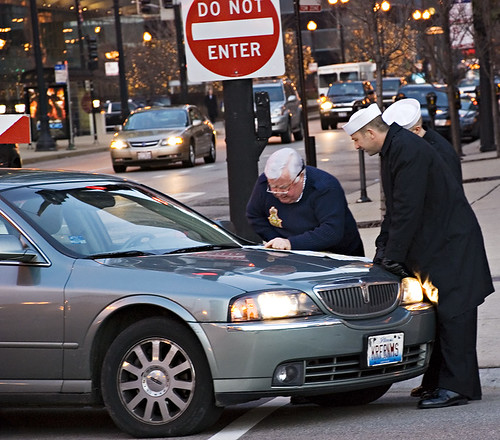
Hope I can make it to both of these exhibits
But Leonardo's relatively diminutive examples of the mapmaker's craft are almost overcome by ancient, awesome and fanciful examples of cartography going back to a clay tablet inscribed with the city plan of Nippur in what is now Iraq, dating from about 1500 B.C. The seven-foot-tall gold and leather-bound 275-pound "Atlas of the Great Elector," created in the 17th century for the Duke of Prussia, opens the exhibition, and before the show ends you can have a look at maps drawn by J.R.R. Tolkien for "The Hobbit" and "The Lord of the Rings."
Curated by James Akerman and Robert Karrow, historians of cartography at Chicago's Newberry Library, this array of 130-odd maps created for wildly different purposes is divided into themes, ranging from "Finding Our Way" to "Mapping the World," "Visualizing Nature and Society" and "Mapping the Imaginary." One of the most affecting examples is a 16th-century world map by Oronco Fine. While this colorful work is mathematically precise for its time, Fine presents the Earth in heart-shaped form, relating the globe to the essence of humanity. A contemporary animated video map from the Abraham Lincoln Presidential Library and Museum in Springfield, Ill., shows the U.S. during the Civil War. In four minutes, it dynamically illustrates the territory held and lost by each side as it pinpoints each of the major battles. The North and the South expand and diminish in the course of the video, until the South is bisected by Sherman's march to the sea and then obliterated.
[From Chicago Marks the Spot For Two Shows About Maps - WSJ.com (Digg-enabled full access for non-WSJ subscribers here)]
MAPS
Field Museum
Through Jan. 27
PTOLEMY'S GEOGRAPHY AND RENAISSANCE MAPMAKERS
Newberry Library
Through Feb. 16
The first towering figure in the history of mapping the world was Claudius Ptolemy, a second-century Alexandrian Greek mathematician, geographer, astronomer and astrologer who developed the latitude and longitude coordinate tables that enabled mapmakers to project the spherical Earth on flat planes. Some of his writings survive and are on view, though none of his maps. But his work was used to make maps for the next millennium, and several dating from the Middle Ages are at the Field. Even more fascinating ones can be seen at the counterpart exhibition running at the Newberry Library ("Ptolemy's Geography and Renaissance Mapmakers," through Feb. 16).
Maps in the Newberry exhibition demonstrate that Ptolemy's geography arguably may have been responsible for Native Americans being known as Indians. He exaggerated the width of the Eurasian continent, which helped to persuade Columbus to sail west to find a simpler, faster way to India. Had Columbus known that Ptolemy had the formulas right but the distances grossly wrong, he might never have set out on his momentous voyage.
The second cartographic giant was the Flemish Gerard Mercator. The Field exhibition includes his 1569 map of the world, which remains the essential projection for getting from one point to another in sea, air and space navigation. It became the standard map projection because of its ability to represent lines of constant true bearing as straight line segments. For example, nearby you can have a look at Charles Lindbergh's New York-to-Paris flight chart with his handwritten notations (1927), which relied on Mercator's projections.
Leonardo's topographical map of Northern Italy is set in the exhibition's section on nature and society, which includes other kinds of maps that help us comprehend what we can't see, including Jane Addams's 1895 map of several Chicago blocks color-coded for ethnicity and income, the Englishman John Snow's scary 1855 map showing the deaths from cholera in a London neighborhood, and Florence Nightingale's "Diagram of the Causes of Mortality in the Army in the East" (1857).
Frank Baum's map of Oz, Robert Louis Stevenson's of Treasure Island, Sir Thomas More's of Utopia, A.A. Milne's of Hundred Acre Wood, William Faulkner's of Yoknapatawpha County and various depictions of hell are in the exhibition's imaginary section. These maps segue nicely into the exhibition's concluding section, which features previously unimaginable things we can do today with maps on the Internet, in our cars, and on our cellphones. These are in no small way due to the almost unbelievable GPS system, whose technology is explained here with the help of Navteq Corp. One of the leading cybermap makers, Navteq is the sponsor of this dazzling collection of the best that man has done to help us figure out where in the world we are, and to find our way home.
